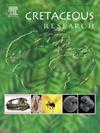德国、捷克北部波西米亚白垩纪盆地砂岩多代物源研究重点为电气石、金红石和石榴石
IF 1.7
3区 地球科学
Q1 GEOLOGY
引用次数: 0
摘要
Kreibitz-Zittau地区(捷克-德国边境波希米亚地块北缘)暴露出一套~ 1000 m厚的Cenomanian-middle Coniacian石英砂岩序列,其成分高,但结构成熟度低。半透明重矿物几乎完全由锆石、电气石和金红石组成(Ø-ZTR成熟度指数为91),电气石占主导地位(平均60%)。金红石中的锆温度记录了上部角闪岩-榴辉岩-麻粒岩相在700 ~ 930℃之间。金红石的Cr/Nb鉴别和电气石的地球化学特征表明,95%的金红石颗粒来源于富al和贫fe - mg的变长岩。金红石碎屑的u - pb年龄在320 ~ 330 Ma有明显的峰值。如果存在,则以铝榴石-欧榴石系列石榴石为主。所有样品中95%的Variscan U-Pb金红石年龄优势和变质作用的高/超高温排除了东北地区芦田地块和Jizera-Krkonoše地块新元古代灰岩和花岗岩类的来源。潜在的原始烃源岩是与今天暴露在沉积区以东约120公里处的片麻质-混染岩Góry Sowie地块内的高等级变质岩相似的岩石。自泥盆纪晚期起,该地块隆起,于石炭世晚期到达地表。因此,广泛分布的二叠-石炭系Variscan molasse是白垩纪砂岩的主要沉积物来源,因此至少在其第二次沉积旋回中沉积。研究表明,结合仔细的岩石学、重矿物分析、矿物特定地球化学和温度测量以及高分辨率地层学的U-Pb年龄定年的综合方法适合解决复杂的物源难题。本文章由计算机程序翻译,如有差异,请以英文原文为准。
Multi-proxy provenance study of sandstones from the northern Bohemian Cretaceous Basin (Germany, Czechia) focused on tourmaline, rutile and garnet
The Kreibitz-Zittau area (northern margin of the Bohemian Massif, Czech-German border region) exposes a ∼1000-m-thick Cenomanian–middle Coniacian succession of quartz arenites with high compositional but low textural maturity. Translucent heavy minerals are almost exclusively composed of zircon, tourmaline and rutile (Ø-ZTR maturity index of 91) with tourmaline predominating (average of 60 %). Zr-in-rutile temperatures document upper amphibolite-eclogite to granulite facies between 700 and 930 °C. Cr/Nb discrimination of rutile and geochemistry of tourmaline indicate that >95 % of these grains originate from Al-rich and Fe–Mg-poor metapelites. U–Pb-ages of detrital rutile show a distinct peak at 320–330 Ma. If present, garnets of the almandine–pyrope series are dominant. The 95 % predominance of Variscan U–Pb rutile ages in all samples and the high/ultrahigh temperatures of metamorphism exclude the Neoproterozoic greywackes and granitoids of the Lusatian Massif and the granitoids of the Jizera–Krkonoše Massif in the northeast as sources. Potential proto source rocks were high-grade metamorphic rocks similar to those today exposed within the gneissic-migmatitic Góry Sowie Massif, ca. 120 km east of the depositional area. Since the late Devonian, this massif was uplifted, reaching the surface in late Carboniferous times. Consequently, the widespread Permo–Carboniferous Variscan molasse is the major sediment source for the Cretaceous sandstones, which thus were deposited during at least their 2nd sedimentary cycle. The study shows that integrated approaches combining careful petrography, heavy mineral analyses, mineral-specific geochemistry and thermometry as well as U–Pb age dating with high-resolution stratigraphy are suited to solve complex provenance puzzles.
求助全文
通过发布文献求助,成功后即可免费获取论文全文。
去求助
来源期刊

Cretaceous Research
地学-地质学
CiteScore
4.10
自引率
19.00%
发文量
235
审稿时长
12 weeks
期刊介绍:
Cretaceous Research provides a forum for the rapid publication of research on all aspects of the Cretaceous Period, including its boundaries with the Jurassic and Palaeogene. Authoritative papers reporting detailed investigations of Cretaceous stratigraphy and palaeontology, studies of regional geology, and reviews of recently published books are complemented by short communications of significant new findings.
Papers submitted to Cretaceous Research should place the research in a broad context, with emphasis placed towards our better understanding of the Cretaceous, that are therefore of interest to the diverse, international readership of the journal. Full length papers that focus solely on a local theme or area will not be accepted for publication; authors of short communications are encouraged to discuss how their findings are of relevance to the Cretaceous on a broad scale.
Research Areas include:
• Regional geology
• Stratigraphy and palaeontology
• Palaeobiology
• Palaeobiogeography
• Palaeoceanography
• Palaeoclimatology
• Evolutionary Palaeoecology
• Geochronology
• Global events.
 求助内容:
求助内容: 应助结果提醒方式:
应助结果提醒方式:


